


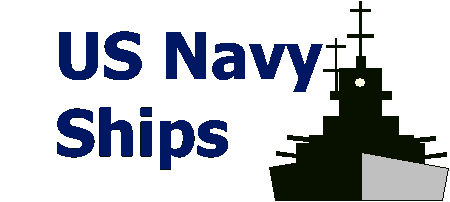
Seabase
Operational Maneuver from the Sea (OMFTS) is the Marine Corps' new warfare doctrine expected to be in place by 2010. The idea is that all logistics support will come from the sea, rather than from a large, land-based supply point (as in traditional combat service support). This means that the several support ships comprising the sea base will have to operate as "floating warehouses," a task for which they are not configured.
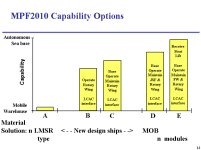 The Marine Corps� concept paper �MPF 2010 and beyond�, signed by the Commandant on 31 December 1997 describes four pillars for future MPF operations and a triad of capabilities. The four pillars describe new capabilities for the MPF ships, to allow full participation in OMFTS and to allow Marine Forces to deploy and be indefinitely supported from an MPF sea base. The capabilities triad describes three capabilities, of which the first and third are increases from today�s capability. Our analysis discovered that all three capabilities could be accomplished with a single type of moderate-speed monohull ship. Fast deployment did not require a fast ship. Sustained sea basing with the full range of logistics support can be done from large conventional ships without the need for a mobile offshore base.
The MPF MAGTF Aviation Combat Element (ACE) is composed of a fixed wing and a rotary wing component. The Marine Corps aviation plan would substitute 5 squadrons (60 aircraft) of VSTOL Joint Strike Fighters (JSF) for the two F/A-18A/B (12 plane), one F/A-18D (12 plane), and one AV-8B (20 plane) squadrons. The KC-130 and EA-6B aircraft remain as in today�s ACE. Similarly three squadrons (36 total aircraft) of MV-22 aircraft are substituted for the two CH-46 (12 plane) and one CH-53D (8 plane) helicopter squadrons. The CH-53E heavy lift helicopter squadron and the attack and utility helicopters remain. The AH-1W and UH-1N helicopters are upgraded to 4 bladed rotors, increasing range and payload.
Two ship design agents, NAVSEA/AME and BLA were tasked to develop cost effective solutions for the intermediate capability options. Cost was to be the principal design driver for their ship and squadron designs. Their scope was to include current and evolving technology to develop solutions that could be achieved within the current state-of-the-art of shipbuilding technology. They succeeded. Their solutions for the intermediate capability options demonstrate that current technology monohull ships can be designed to meet the requirements for the MPF 2010 sea-basing capability. The final MPF 2010 ship design will probably incorporate features from both design agents, and will be a blend of the best technologies of both designers.
The Marine Corps� concept paper �MPF 2010 and beyond�, signed by the Commandant on 31 December 1997 describes four pillars for future MPF operations and a triad of capabilities. The four pillars describe new capabilities for the MPF ships, to allow full participation in OMFTS and to allow Marine Forces to deploy and be indefinitely supported from an MPF sea base. The capabilities triad describes three capabilities, of which the first and third are increases from today�s capability. Our analysis discovered that all three capabilities could be accomplished with a single type of moderate-speed monohull ship. Fast deployment did not require a fast ship. Sustained sea basing with the full range of logistics support can be done from large conventional ships without the need for a mobile offshore base.
The MPF MAGTF Aviation Combat Element (ACE) is composed of a fixed wing and a rotary wing component. The Marine Corps aviation plan would substitute 5 squadrons (60 aircraft) of VSTOL Joint Strike Fighters (JSF) for the two F/A-18A/B (12 plane), one F/A-18D (12 plane), and one AV-8B (20 plane) squadrons. The KC-130 and EA-6B aircraft remain as in today�s ACE. Similarly three squadrons (36 total aircraft) of MV-22 aircraft are substituted for the two CH-46 (12 plane) and one CH-53D (8 plane) helicopter squadrons. The CH-53E heavy lift helicopter squadron and the attack and utility helicopters remain. The AH-1W and UH-1N helicopters are upgraded to 4 bladed rotors, increasing range and payload.
Two ship design agents, NAVSEA/AME and BLA were tasked to develop cost effective solutions for the intermediate capability options. Cost was to be the principal design driver for their ship and squadron designs. Their scope was to include current and evolving technology to develop solutions that could be achieved within the current state-of-the-art of shipbuilding technology. They succeeded. Their solutions for the intermediate capability options demonstrate that current technology monohull ships can be designed to meet the requirements for the MPF 2010 sea-basing capability. The final MPF 2010 ship design will probably incorporate features from both design agents, and will be a blend of the best technologies of both designers.
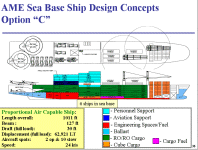 On the sea base ship for options �C�, �C(+)�, and �D� helicopters are based aboard the sea base, and proportionally loaded on each of the 6 ships required in the squadron. The ship is similar in size to the minimum air capable ship shown earlier, but a small hangar deck fills the bottom after portion of the superstructure. Each ship can carry 10 folded helicopters plus 2 additional operational spots for helicopters. The hangar deck can hold 5 helicopters. Aircraft stowed in the hangar impact the ramp for delivery of cargo to the flight deck. A single large ship optimized for point-to-point delivery of the fixed wing portion of the ACE is required to complete the MPF squadron.
On the sea base ship for options �C�, �C(+)�, and �D� helicopters are based aboard the sea base, and proportionally loaded on each of the 6 ships required in the squadron. The ship is similar in size to the minimum air capable ship shown earlier, but a small hangar deck fills the bottom after portion of the superstructure. Each ship can carry 10 folded helicopters plus 2 additional operational spots for helicopters. The hangar deck can hold 5 helicopters. Aircraft stowed in the hangar impact the ramp for delivery of cargo to the flight deck. A single large ship optimized for point-to-point delivery of the fixed wing portion of the ACE is required to complete the MPF squadron.
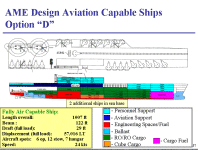 The option �D� capability to sea-base the VSTOL JSF aircraft is achieved by adding two of the fully air capable ships pictured above to the option �C� squadron. Each has the capacity to operate and service 30 JSF aircraft. The flight deck, hangar deck and aviation shops are well laid out. Option �D� requires 8 total ships -- 6 proportionally air capable helicopter sea-base ships, and 2 JSF fully air capable ships. The large number of ships makes this option costly to procure and operate.
The option �D� capability to sea-base the VSTOL JSF aircraft is achieved by adding two of the fully air capable ships pictured above to the option �C� squadron. Each has the capacity to operate and service 30 JSF aircraft. The flight deck, hangar deck and aviation shops are well laid out. Option �D� requires 8 total ships -- 6 proportionally air capable helicopter sea-base ships, and 2 JSF fully air capable ships. The large number of ships makes this option costly to procure and operate.
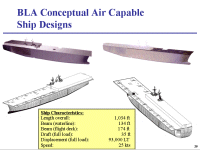 The two BLA sea base ships share a common hull, and internal design to the main deck. The minimum air capable ship, on the left, has a flight deck forward, and a large superstructure house aft. The fully air capable ship, on the right, has a smaller superstructure house on the aft-starboard side of the flight deck, and more open deck space, including a full 1,000 feet for JSF takeoff runway. Both ships have a port side quarter-stern ramp for pierside RO/RO discharge, and a external integrated landing platform (ILP) for assault craft interface on the starboard quarter. The flight deck has a 40 foot overhang on the port side. The internal-external gantry crane system rails run under this overhang. The cranes travel from the internal, under flight deck area through large cargo hatches to the external rails. The ILP and gantry crane system limit the ship to berths �port side to� the pier. The flight decks are not optimized for naval aircraft operations. Helicopters and VSTOL aircraft routinely land from the aft of the ship. The arrangement of the superstructure requires aircraft to land forward of the deck house. The JSF takeoff runway requires planes to taxi down the runway and turn in the narrowest part of the deck. The cargo/aircraft elevator also interrupts the takeoff run area. All of these design issues could be corrected in subsequent stages of design with little additional cost.
The two BLA sea base ships share a common hull, and internal design to the main deck. The minimum air capable ship, on the left, has a flight deck forward, and a large superstructure house aft. The fully air capable ship, on the right, has a smaller superstructure house on the aft-starboard side of the flight deck, and more open deck space, including a full 1,000 feet for JSF takeoff runway. Both ships have a port side quarter-stern ramp for pierside RO/RO discharge, and a external integrated landing platform (ILP) for assault craft interface on the starboard quarter. The flight deck has a 40 foot overhang on the port side. The internal-external gantry crane system rails run under this overhang. The cranes travel from the internal, under flight deck area through large cargo hatches to the external rails. The ILP and gantry crane system limit the ship to berths �port side to� the pier. The flight decks are not optimized for naval aircraft operations. Helicopters and VSTOL aircraft routinely land from the aft of the ship. The arrangement of the superstructure requires aircraft to land forward of the deck house. The JSF takeoff runway requires planes to taxi down the runway and turn in the narrowest part of the deck. The cargo/aircraft elevator also interrupts the takeoff run area. All of these design issues could be corrected in subsequent stages of design with little additional cost.
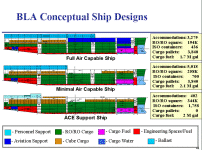 The three BLA designs are identical to the �B� deck, just below the main deck. The ACE support ship has the main deck removed aft to allow more containers to be stowed (up to 4 high) on the �B� deck below. The two sea base ships are identical to the flight deck, with only the superstructure house different. The use of only 3 total ship designs leaves some of the capability options sub-optimized. The option �B� ACE support ship must carry the supplies for the full ACE. In option �C�, the rotary wing portion of the ACE is based aboard one of the fully air capable ships, and the ACE support ship is significantly underutilized.
Options �C� and �D� carry significantly more cargo fuel than required. BLA felt the acquisition savings from identical hull forms was more important than exactly matching the required lift to the squadron. Small changes in the fuel capacity can fix some of these problems. A redesign to optimize the BLA �C� option into 4 ships with identical hull forms -- one sea base design with 3 ships and a single ACE support ship should be pursued.
The three BLA designs are identical to the �B� deck, just below the main deck. The ACE support ship has the main deck removed aft to allow more containers to be stowed (up to 4 high) on the �B� deck below. The two sea base ships are identical to the flight deck, with only the superstructure house different. The use of only 3 total ship designs leaves some of the capability options sub-optimized. The option �B� ACE support ship must carry the supplies for the full ACE. In option �C�, the rotary wing portion of the ACE is based aboard one of the fully air capable ships, and the ACE support ship is significantly underutilized.
Options �C� and �D� carry significantly more cargo fuel than required. BLA felt the acquisition savings from identical hull forms was more important than exactly matching the required lift to the squadron. Small changes in the fuel capacity can fix some of these problems. A redesign to optimize the BLA �C� option into 4 ships with identical hull forms -- one sea base design with 3 ships and a single ACE support ship should be pursued.
Sources and Resources
http://www.fas.org/man/dod-101/sys/ship/seabase.htm
Maintained by Robert Sherman
Originally created by John Pike
Updated Thursday, October 19, 2000 6:13:29 AM




 The Marine Corps� concept paper �MPF 2010 and beyond�, signed by the Commandant on 31 December 1997 describes four pillars for future MPF operations and a triad of capabilities. The four pillars describe new capabilities for the MPF ships, to allow full participation in OMFTS and to allow Marine Forces to deploy and be indefinitely supported from an MPF sea base. The capabilities triad describes three capabilities, of which the first and third are increases from today�s capability. Our analysis discovered that all three capabilities could be accomplished with a single type of moderate-speed monohull ship. Fast deployment did not require a fast ship. Sustained sea basing with the full range of logistics support can be done from large conventional ships without the need for a mobile offshore base.
The MPF MAGTF Aviation Combat Element (ACE) is composed of a fixed wing and a rotary wing component. The Marine Corps aviation plan would substitute 5 squadrons (60 aircraft) of VSTOL Joint Strike Fighters (JSF) for the two F/A-18A/B (12 plane), one F/A-18D (12 plane), and one AV-8B (20 plane) squadrons. The KC-130 and EA-6B aircraft remain as in today�s ACE. Similarly three squadrons (36 total aircraft) of MV-22 aircraft are substituted for the two CH-46 (12 plane) and one CH-53D (8 plane) helicopter squadrons. The CH-53E heavy lift helicopter squadron and the attack and utility helicopters remain. The AH-1W and UH-1N helicopters are upgraded to 4 bladed rotors, increasing range and payload.
Two ship design agents, NAVSEA/AME and BLA were tasked to develop cost effective solutions for the intermediate capability options. Cost was to be the principal design driver for their ship and squadron designs. Their scope was to include current and evolving technology to develop solutions that could be achieved within the current state-of-the-art of shipbuilding technology. They succeeded. Their solutions for the intermediate capability options demonstrate that current technology monohull ships can be designed to meet the requirements for the MPF 2010 sea-basing capability. The final MPF 2010 ship design will probably incorporate features from both design agents, and will be a blend of the best technologies of both designers.
The Marine Corps� concept paper �MPF 2010 and beyond�, signed by the Commandant on 31 December 1997 describes four pillars for future MPF operations and a triad of capabilities. The four pillars describe new capabilities for the MPF ships, to allow full participation in OMFTS and to allow Marine Forces to deploy and be indefinitely supported from an MPF sea base. The capabilities triad describes three capabilities, of which the first and third are increases from today�s capability. Our analysis discovered that all three capabilities could be accomplished with a single type of moderate-speed monohull ship. Fast deployment did not require a fast ship. Sustained sea basing with the full range of logistics support can be done from large conventional ships without the need for a mobile offshore base.
The MPF MAGTF Aviation Combat Element (ACE) is composed of a fixed wing and a rotary wing component. The Marine Corps aviation plan would substitute 5 squadrons (60 aircraft) of VSTOL Joint Strike Fighters (JSF) for the two F/A-18A/B (12 plane), one F/A-18D (12 plane), and one AV-8B (20 plane) squadrons. The KC-130 and EA-6B aircraft remain as in today�s ACE. Similarly three squadrons (36 total aircraft) of MV-22 aircraft are substituted for the two CH-46 (12 plane) and one CH-53D (8 plane) helicopter squadrons. The CH-53E heavy lift helicopter squadron and the attack and utility helicopters remain. The AH-1W and UH-1N helicopters are upgraded to 4 bladed rotors, increasing range and payload.
Two ship design agents, NAVSEA/AME and BLA were tasked to develop cost effective solutions for the intermediate capability options. Cost was to be the principal design driver for their ship and squadron designs. Their scope was to include current and evolving technology to develop solutions that could be achieved within the current state-of-the-art of shipbuilding technology. They succeeded. Their solutions for the intermediate capability options demonstrate that current technology monohull ships can be designed to meet the requirements for the MPF 2010 sea-basing capability. The final MPF 2010 ship design will probably incorporate features from both design agents, and will be a blend of the best technologies of both designers.
 On the sea base ship for options �C�, �C(+)�, and �D� helicopters are based aboard the sea base, and proportionally loaded on each of the 6 ships required in the squadron. The ship is similar in size to the minimum air capable ship shown earlier, but a small hangar deck fills the bottom after portion of the superstructure. Each ship can carry 10 folded helicopters plus 2 additional operational spots for helicopters. The hangar deck can hold 5 helicopters. Aircraft stowed in the hangar impact the ramp for delivery of cargo to the flight deck. A single large ship optimized for point-to-point delivery of the fixed wing portion of the ACE is required to complete the MPF squadron.
On the sea base ship for options �C�, �C(+)�, and �D� helicopters are based aboard the sea base, and proportionally loaded on each of the 6 ships required in the squadron. The ship is similar in size to the minimum air capable ship shown earlier, but a small hangar deck fills the bottom after portion of the superstructure. Each ship can carry 10 folded helicopters plus 2 additional operational spots for helicopters. The hangar deck can hold 5 helicopters. Aircraft stowed in the hangar impact the ramp for delivery of cargo to the flight deck. A single large ship optimized for point-to-point delivery of the fixed wing portion of the ACE is required to complete the MPF squadron.
 The option �D� capability to sea-base the VSTOL JSF aircraft is achieved by adding two of the fully air capable ships pictured above to the option �C� squadron. Each has the capacity to operate and service 30 JSF aircraft. The flight deck, hangar deck and aviation shops are well laid out. Option �D� requires 8 total ships -- 6 proportionally air capable helicopter sea-base ships, and 2 JSF fully air capable ships. The large number of ships makes this option costly to procure and operate.
The option �D� capability to sea-base the VSTOL JSF aircraft is achieved by adding two of the fully air capable ships pictured above to the option �C� squadron. Each has the capacity to operate and service 30 JSF aircraft. The flight deck, hangar deck and aviation shops are well laid out. Option �D� requires 8 total ships -- 6 proportionally air capable helicopter sea-base ships, and 2 JSF fully air capable ships. The large number of ships makes this option costly to procure and operate.
 The two BLA sea base ships share a common hull, and internal design to the main deck. The minimum air capable ship, on the left, has a flight deck forward, and a large superstructure house aft. The fully air capable ship, on the right, has a smaller superstructure house on the aft-starboard side of the flight deck, and more open deck space, including a full 1,000 feet for JSF takeoff runway. Both ships have a port side quarter-stern ramp for pierside RO/RO discharge, and a external integrated landing platform (ILP) for assault craft interface on the starboard quarter. The flight deck has a 40 foot overhang on the port side. The internal-external gantry crane system rails run under this overhang. The cranes travel from the internal, under flight deck area through large cargo hatches to the external rails. The ILP and gantry crane system limit the ship to berths �port side to� the pier. The flight decks are not optimized for naval aircraft operations. Helicopters and VSTOL aircraft routinely land from the aft of the ship. The arrangement of the superstructure requires aircraft to land forward of the deck house. The JSF takeoff runway requires planes to taxi down the runway and turn in the narrowest part of the deck. The cargo/aircraft elevator also interrupts the takeoff run area. All of these design issues could be corrected in subsequent stages of design with little additional cost.
The two BLA sea base ships share a common hull, and internal design to the main deck. The minimum air capable ship, on the left, has a flight deck forward, and a large superstructure house aft. The fully air capable ship, on the right, has a smaller superstructure house on the aft-starboard side of the flight deck, and more open deck space, including a full 1,000 feet for JSF takeoff runway. Both ships have a port side quarter-stern ramp for pierside RO/RO discharge, and a external integrated landing platform (ILP) for assault craft interface on the starboard quarter. The flight deck has a 40 foot overhang on the port side. The internal-external gantry crane system rails run under this overhang. The cranes travel from the internal, under flight deck area through large cargo hatches to the external rails. The ILP and gantry crane system limit the ship to berths �port side to� the pier. The flight decks are not optimized for naval aircraft operations. Helicopters and VSTOL aircraft routinely land from the aft of the ship. The arrangement of the superstructure requires aircraft to land forward of the deck house. The JSF takeoff runway requires planes to taxi down the runway and turn in the narrowest part of the deck. The cargo/aircraft elevator also interrupts the takeoff run area. All of these design issues could be corrected in subsequent stages of design with little additional cost.
 The three BLA designs are identical to the �B� deck, just below the main deck. The ACE support ship has the main deck removed aft to allow more containers to be stowed (up to 4 high) on the �B� deck below. The two sea base ships are identical to the flight deck, with only the superstructure house different. The use of only 3 total ship designs leaves some of the capability options sub-optimized. The option �B� ACE support ship must carry the supplies for the full ACE. In option �C�, the rotary wing portion of the ACE is based aboard one of the fully air capable ships, and the ACE support ship is significantly underutilized.
Options �C� and �D� carry significantly more cargo fuel than required. BLA felt the acquisition savings from identical hull forms was more important than exactly matching the required lift to the squadron. Small changes in the fuel capacity can fix some of these problems. A redesign to optimize the BLA �C� option into 4 ships with identical hull forms -- one sea base design with 3 ships and a single ACE support ship should be pursued.
The three BLA designs are identical to the �B� deck, just below the main deck. The ACE support ship has the main deck removed aft to allow more containers to be stowed (up to 4 high) on the �B� deck below. The two sea base ships are identical to the flight deck, with only the superstructure house different. The use of only 3 total ship designs leaves some of the capability options sub-optimized. The option �B� ACE support ship must carry the supplies for the full ACE. In option �C�, the rotary wing portion of the ACE is based aboard one of the fully air capable ships, and the ACE support ship is significantly underutilized.
Options �C� and �D� carry significantly more cargo fuel than required. BLA felt the acquisition savings from identical hull forms was more important than exactly matching the required lift to the squadron. Small changes in the fuel capacity can fix some of these problems. A redesign to optimize the BLA �C� option into 4 ships with identical hull forms -- one sea base design with 3 ships and a single ACE support ship should be pursued.